Astrolabes are incredible pieces of astronomical equipment, used by the stargazers of antiquity to track the motions of the heavens. But as time and technology progressed they fell out of use, and have now become mysterious curiosities found in museum gift shops and at astronomy conventions.
It you’ve ever seen an astrolabe, you’ve no doubt wondered at its many spokes and dials and thought - ‘how do you use an astrolabe, anyway’?
Mastering an astrolabe can take years of practice, but in this guide we’ll reveal all you need to know to get started with this incredibly intricate instrument.
For more newcomers' advice, read our guide to astronomy for beginners

What is an astrolabe?
An astrolabe is an astronomical instrument used since ancient times.
It consists of rotating discs and rulers to show the positions of astronomical objects at any given time throughout the year.
An astrolabe has many uses, including:
- Telling the time during the day and night
- Predicting the time the Sun will rise or set
- Measuring the altitude of an astronomical object in the sky
As they were also developed in a time when astronomy and astrology were interchangeable practices, they were also used to read horoscopes. Many of the ancient examples used the signs of the zodiac by way of a calendar.
They were complicated instruments requiring high levels of craft to produce, and as such their designs were often decorated with inscriptions and patterns to make them even more beautiful.
Today, there are more modern versions available, which dispense with much of the decoration in favour of a clear, easy to read layout.
Who invented the astrolabe?
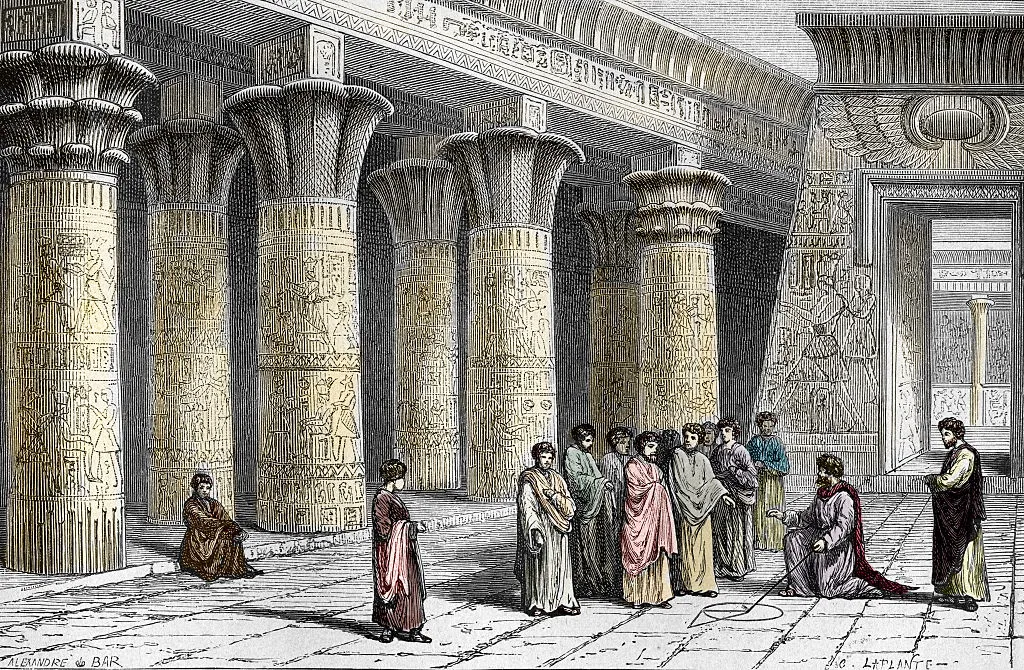
The astrolabe was invented by Greek astronomer and geometer Apollonius of Perga between 220 and 150 BC when he combined the existing planisphere with an astronomical instrument called a dioptra.
In the subsequent centuries, its use spread throughout Europe, Asia and North Africa.
Many astronomers further developed the instrument and refined its use, particularly those in the Islamic world as they were used to measure both the time prayer should be conducted and the direction of Mecca.
How does an astrolabe work?
Astrolabes consist of several different components that all function together to predict the motions of the heavens:
Mater
An outer ring marked with degrees. These can sometimes be used to represent the hours of the day as well as angles.
Plate
A backing disc with grid markings representing right ascension and declination, as well as a line to represent the horizon. Just like modern planispheres, these plates are specific to a given latitude.
Rete
A rotating disc overlaying the plate. The rete has many cutouts that allow you to see the plate beneath, while the remaining shapes create points representing the locations of the brightest stars in the sky. Within the rete is a ring shape that represents the ecliptic plane, often divided into the months of the year or signs of the zodiac.
Rule
A straight bar across the main face. It is attached at the centre and spins around the face, pointing towards the Mater ring, to measure the angle of certain objects.
Alidade
The rotating bar found on the back of the astrolabe that is used as a sight. Most have wings on the end, sometimes with pin pricks that let through light allowing the user to align it during the day without having to look directly at the Sun.
How to use an astrolabe

The astrolabe is a complex instrument that can be used in dozens of different ways and mastering its use took years of practice.
Much of its use comes from twisting the rete and rule – perhaps to match a given sky location on the plate, or to a particular time on the mater – and then knowing which part to look at to read off the piece of information you need.
Here are a couple of examples of what you can do using an astrolabe at home.
Measure the position of the Sun with an astrolabe
- Hold the astrolabe vertically. Most will have a loop you can attach a strap or rope to so that you can hang the astrolabe and allow gravity to keep it straight.
- Align the alidade with the Sun. As you should avoid looking directly at the Sun at all times, instead use the shadow of the alidade to guide you - the shadow will look narrowest when its aligned. Some astrolabes have pin pricks in the alidade, which will allow through a dot of light when it is aligned.
- Read off the angle of the alidade from the ring on the back of the astrolabe.
- Check online to see if you've got it right.
- It's also possible to use this same procedure to measure the position of the stars or Moon with an astrolabe, but in this case you can safely sight the star by looking along the alidade.
Tell the time with an astrolabe
- Measure the angle of the Sun using the guide above.
- Holding the astrolabe with the front side up, turn the ruler to line up with the current date on the ecliptic ring.
- The lines on the plate correspond to altitude, so find the altitude line that matches what you measured for the Sun. (depending on the resolution of your astrolabe, you may have to approximate).
- Turn the rete and rule together so that the intersection of the rule and the ecliptic circle also intersects with the altitude line.
- Look at where the ruler is pointing and read off the time.
Where to get an astrolabe
There are a huge number of astrolabes for sale out there.While genuine antique astrolabes are extremely expensive, there are many affordable replicas available.
These recreate the vintage beauty of astrolabes, but are meant to be display pieces and not to actually be used.
Fortunately, there are many modern versions that are much more user friendly that you can also buy, and even guides out there that will help you make your own (though if you want to make one from wood or plastic, you will probably need access to a laser cutter).
Whether you’re looking for yourself or for a friend interested in astronomy history, here we list our picks available on the market today.
Traditional astrolabes
Decorative astrolabe and calendar

Crafted to look like antique brass and hung from its accompanying wooden stand, this astrolabe replica makes a wonderful showpiece that harkens back to the astrolabes used in centuries past.
The face of the astrolabe measures 4-inches in diameter, with a height of 8-inches when hung up.
It comes with several interchangeable plates, allowing you to adjust the astrolabe to best fit your aesthetic.
The back of the astrolabe has the calendar marked up with images representing the signs of the zodiac, meaning it looks attractive whichever side you view it from.
Brass Islamic-style astrolabe decoration
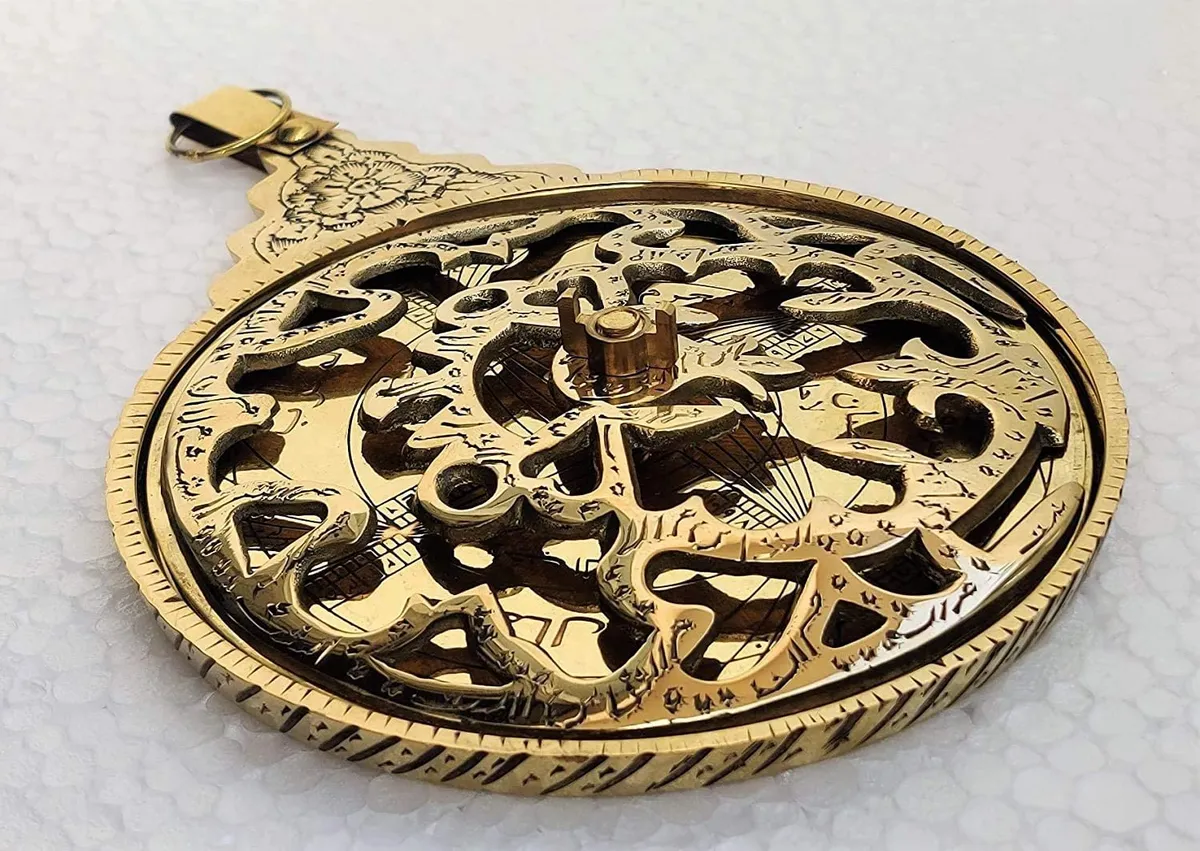
This brass effect astrolabe is inscribed with Arabic script as would be found on the astrolabes used by ancient Islamic stargazers.
With a flat back, this astrolabe is designed as a home decoration, and can be hung on the wall, while the highly polished finish brass will make it glitter and shine – brightening up any room it hangs in.
There are several interchangeable plates, so you can decide which one you think suits it best, or to change its function.
A striking gift for an astronomer with a taste for the history of astronomy.
Measures 10-inches in diameter.
Astrolabe Asineus
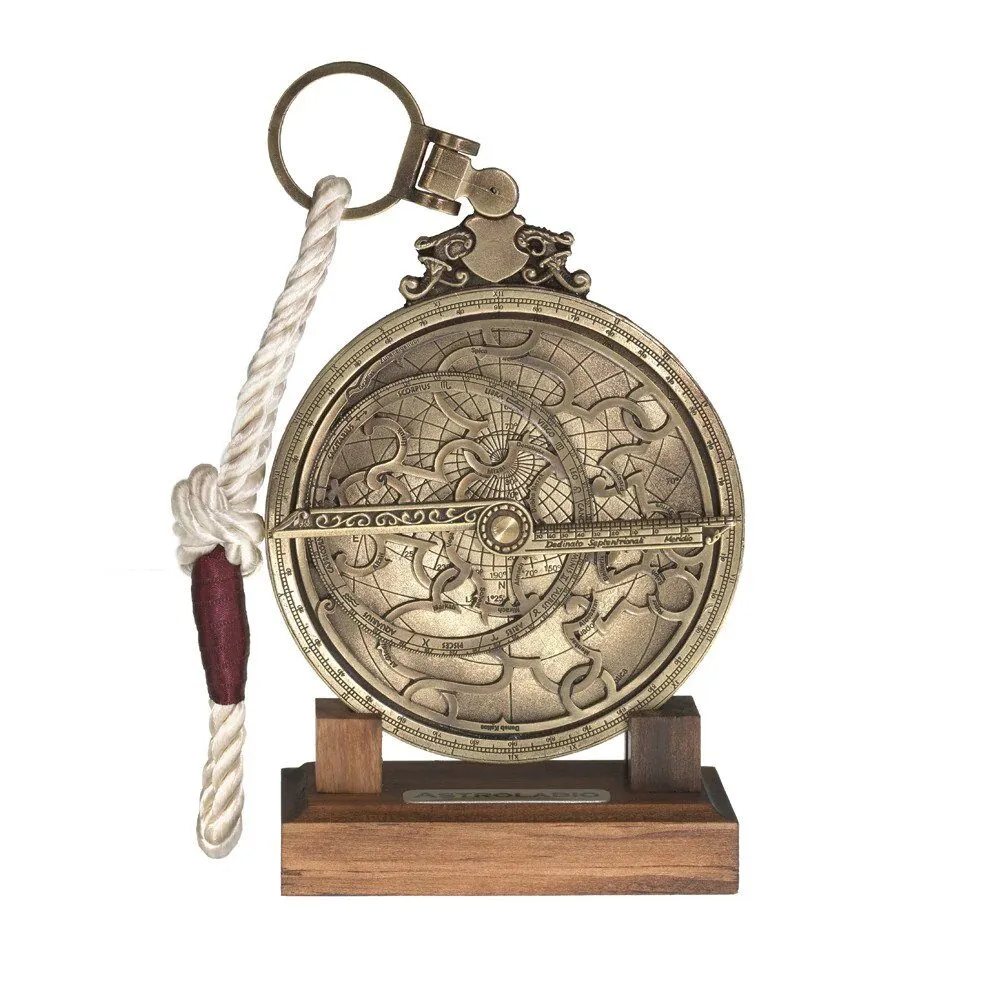
- Buy now from Royal Museums Greenwich
This astrolabe’s rete is designed with slender lines weaving in and out of each other to create a beautiful design, and is inscribed with the names of stars so that you know which star each pointer is associated with.
One half of the rule is decorated with intricate filigree, while the other bears ruler marking to help make position measurements far more precisely.
Measuring 10cm across, it comes with a labelled wooden stand, as well as a rope that can be used to hang it from the wall or just as decoration.
Though this astrolabe could be used, it is primarily intended to be a decoration.
Hartmann’s planispherical astrolabe
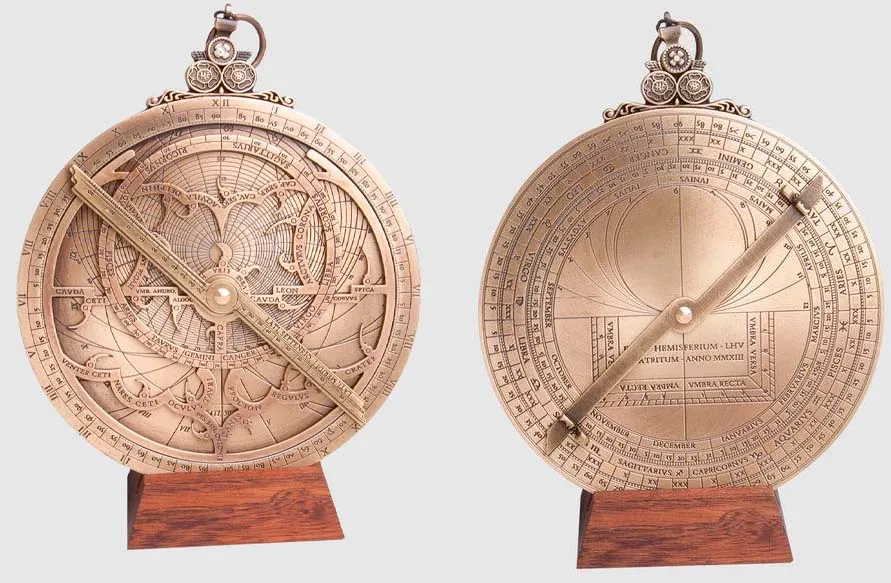
- Buy now from Curious Minds.
This astrolabe is based on the instrument manufactured by German instrument maker Georg Hartmann in the 16th century – you can see the original in the British Museum, London.
The star pointers on the rete are all labelled with the names of stars, while the ecliptic ring bears the signs of the zodiac.
As this is based on an actual astronomical instrument and is crafted to a high level, with fine detail on the altitude lines and degree markings, this a great option if you are looking for an astrolabe that is not just beautiful, but functional as well (though it is primarily designed as a display item).
Modern astrolabes and astrolabe kits
Astromedia Stardial
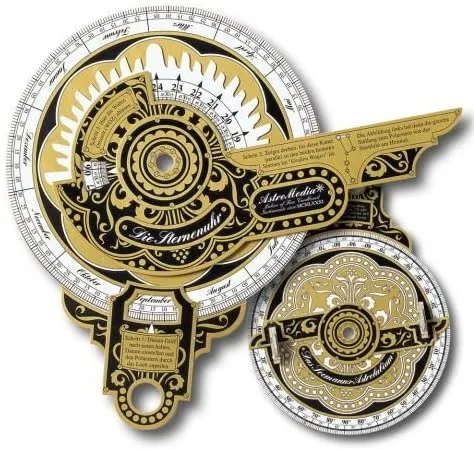
Though not a full astrolabe, this cardboard kit helps you create a stardial – a simplified device that lets you perform several of the astrolabes most useful functions.
One side contains the star dial which allows you to tell the time using just the north star and the Plough.
The time can be both read off from the marks around the outside, or by using your fingers to feel the series of dips and dents in the inner ring when it’s too dark to see.
Meanwhile the reverse has the alidade and degree ring you’d find on the back of an astrolabe that will allow you to measure the height of objects in the sky.
Made from cardboard, this is a low cost option for those dipping their toe into the astrolabe waters.
Wooden astrolabe by MAPospheres
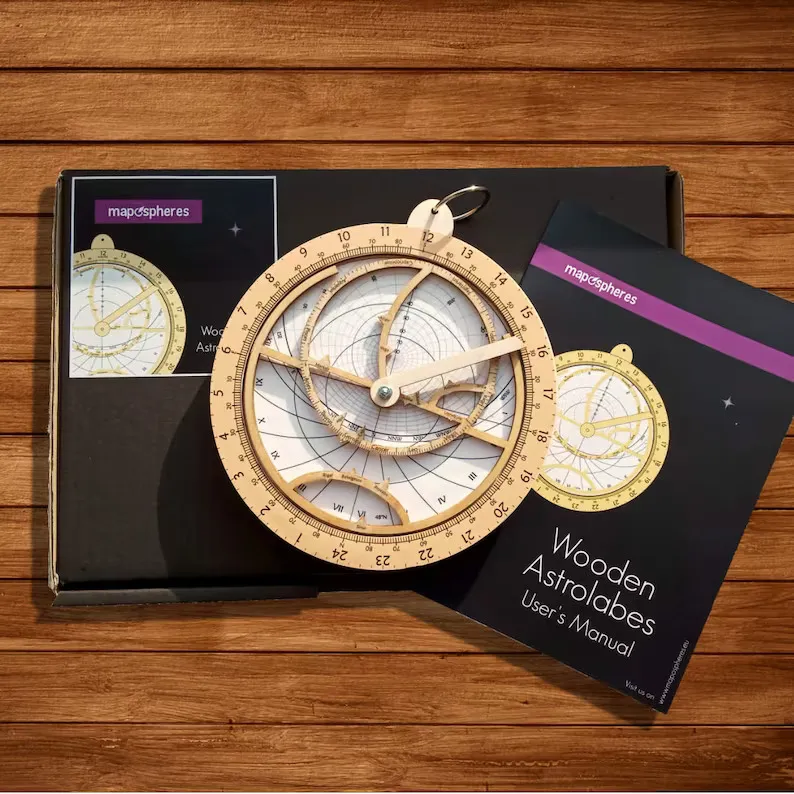
- Buy now from Etsy
If you are looking to learn how to actually use an astrolabe, this kit is a great place to start.
The rete is highlight simplified compared to ancient designs, making it much more practical when using in the field, and the numbers and marks are all clearly written.
The astrolabe is 16.5cm wide, but is crafted from lightweight plywood so that you won’t pull a muscle when trying to use it.
The kit comes with all the pieces you need to assemble the device yourself if you want to make your own astrolabe, or you can request a preassembled version if you prefer.
You can request what latitude you would like the plate to be set to in the personalisation options.
Comes with a 20 page user’s manual with the history and main uses of the astrolabe.
Deluxe wooden kit Astrolabe from Laserdeko
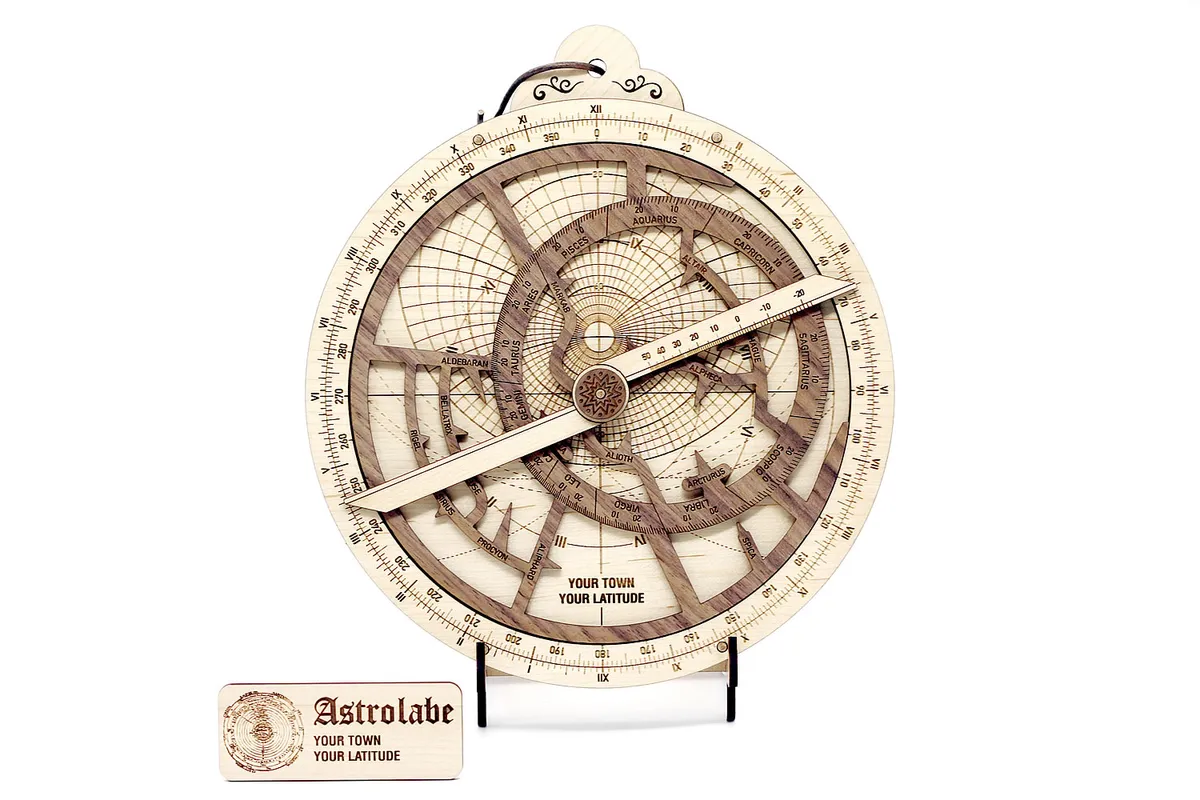
- Buy now from Etsy
Laser cut and engraved onto premium maple and walnut wood, this is a great option if you want a practical astrolabe that is also visually striking
The rete balances a simplified structure that is easy to understand with large space to see the plate below, with pointers highlighting a multitude of northern hemisphere stars.
The default plate is set to a latitude of 50ºN, which will work well for much of the UK, though those towards the north of the country or in other parts of the world may wish to utilise the option to have a custom plate made to their specific latitude.
Comes with building instructions and a guide on how to use it.
Measures 22cm across.
A more budget friendly astrolabe is also available.
